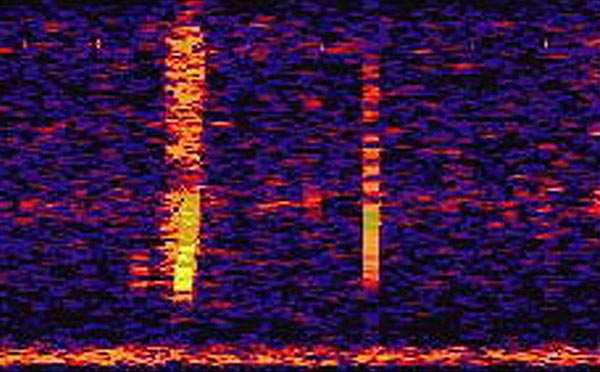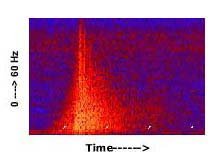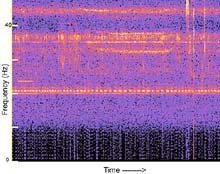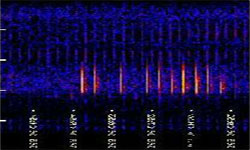
Bloop
In the late 1940s, the U.S. Navy began to develop the Sound Surveillance System, an array of passive sonar stations designed to track Soviet submarines. By the late 1980s, SOSUS became surplus goods, as the USSR blinked out of existence.
The National Oceanic and Atmospheric Administration began to utilize the system to study the acoustics of the seas. To complement SOSUS, they created the Equatorial Pacific Ocean autonomous hydrophone array. NOAA hoped to learn about underwater seismicity, the sounds of ice in the polar regions, and the sonic prints of ocean mammals.
This mission chugged along, largely unassumingly, until the summer of 1997. Out of the deep blue emanated a sound, unlike anything anyone had heard before. Technically, human ears couldn’t hear the sound, as it took the form of an ultra-low-frequency wave, below the threshold of our ears. The hydrophones, however, had no problem picking out what scientists later dubbed “Bloop.”
For humans to hear the sound file above, the Bloop needed to be played at 16 times its normal speed.
According to NOAA, the wave lasted about a minute. Obviously, this sound is bizarre. What could create such a sound in the ocean? Perhaps the oddest part about the Bloop, though, is that it was really, really loud. Despite the fact that we can’t hear the low frequency, the sound carried over an extraordinary distance. Multiple hydrophones, at a range of 5,000 kilometers (3,000 miles), registered the Bloop. That’s longer than the distance between New York and Los Angeles!
Scientists quickly ruled out ships made by humans, as the spectrograms – visual representations of sound waves – did not match those made by artificial craft. Just in case, NOAA approached the Navy to see if the sound had come from secret technology. The government claimed it could not take credit. The signatures did not correspond to normal sounds coming from underwater earthquakes or volcanoes, either.



The Bloop’s origin baffled researchers. Though they found the notion implausible, the spectrogram of the Bloop did share certain characteristics with those of large whales. Could this bizarre noise come from an undiscovered denizen of the deep?
Christopher Fox, the principal investigator of NOAA’s Pacific Marine Environmental Laboratory, caused an unintended media kerfuffle after he described Bloop in an article in New Scientist. He noted the audio signature shared similarities with those of living creatures, but that the source still remained a mystery because of its intensity. Fox stated if the source were mammalian it would be “far more powerful than the calls made by any animal on Earth.”
Cryptozoologists and enterprising media personalities ran with the notion. Even though Fox had not stated a giant creature had created Bloop, he provided enough fodder to run with the possibility. The largest known creature – the blue whale – cannot produce amplitudes high enough to be heard at 5,000 kilometers. Blue whales can reach up to 100 feet in length and 200 tons. The Bloop’s creature would need to dwarf the largest animal ever known to exist. Could something organic have produced the Bloop? Many wanted to believe.


Alas, a gargantuan underwater creature is not the source of Bloop.
As NOAA continued to learn more about the sounds of the oceans, spectrograms that more closely matched that of the Bloop emerged.
The culprit: ice.
Specifically, non-tectonic cryoseisms, also known as icequakes. These events occur when massive icebergs begin to fracture internally. In 2008, iceberg A53a disintegrated near South Georgia Island. Not only did icequakes from this mass produce spectrograms that resembled Bloop, but they also created amplitudes that traveled at least 5,000 kilometers. NOAA now believes with a high degree of certainty that icequakes conjured Bloop.
The berg that likely produced Bloop quaked somewhere near 50 degrees south latitude and 100 degrees west longitude, a remote spot west of the tip of South America, not too far from Point Nemo. Of course, since we cannot yet time travel to check the iceberg theory, there are some who will continue to believe a monster roams the ocean. Or something else entirely!

Further Reading and Exploration
Icequakes (Bloop) – NOAA
The Bloop – Skeptoid
The Bloop mystery has been solved: it was never a giant sea monster – Wired














Pingback: The Hole Story – themountainsarecalling.earth